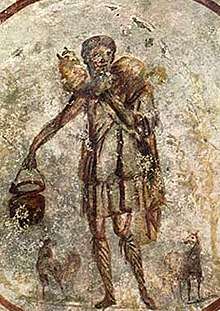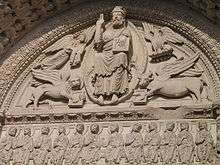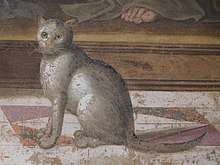Animals in Christian art
In Christian art, animal forms have at times occupied a place of importance. With the Renaissance, animals were nearly banished, except as an accessory to the human figure. Modern Christian art only revives symbols and decoration.
Late Antique period
In the early days of Latin and Byzantine Christianity, as well as in the period of its full bloom in the Middle Ages, a prodigious number of representations of animals is found not only in monumental sculpture, but in illuminated manuscripts, in stained glass windows, and in tapestry as well. Three reasons may be given for this unexampled fondness for animal life:[1]
- It affords an easy medium of expressing or symbolizing a virtue or a vice, by means of the virtue or vice usually attributed to the animal represented.[1]
- Animal forms were traditional elements of decoration.[1]
- Medieval designers returned to the direct study of nature, including man, the lower animals, and the humblest plants.[1]
Symbolic animals from the catacombs

The paintings of the first period, as seen in the Catacombs of Rome, show us, usually, the lamb accompanying the Good Shepherd, a representation of the Christian soul during its earthly life.[1] The lamb was strongly associated with religious sacrifices in the ancient Near East, and was adopted as a symbol of Christ and his sacrifice on behalf of humanity.[2]
Birds, too, appear either as simple decorative elements transmitted from antique paintings, or used symbolically as in Noah's dove, symbolical of the Christian soul released by death; the peacock, with its ancient meaning of immortality, and the phoenix, the symbol of apotheosis.[1]
The symbol of perhaps the widest distribution is the Ichthys (Greek: ΙΧΘΥΣ, fish), used since the second century as an acronym for "Ίησοῦς Χριστός, Θεοῦ Υἱός, Σωτήρ" (Iesous Christos, Theou Huios, Soter), meaning "Jesus Christ, Son of God, Saviour".[3] Artistically, these various representations are somewhat crude, and show the decadence of the pagan art of the time.[1]
Animals from the Book of Revelation
After the recognition of the Church by Constantine I in 313, the Book of Revelation is the source from which are derived most of the decorative themes of Christian Art. The lamb is now the most important of these, and its meaning is either the same as before or, more frequently perhaps, it is symbolic of Christ the expiatory victim. The dove is the Holy Spirit, and the four animals that St. John saw in Heaven[4] are used as personifications of the Four Evangelists.[1][5][6] Under the influence of Byzantine art, a great variety of fantastic animals, such as dragons, birds with human heads, winged lions, etc., entwined themselves around the decorative forms until foreign wars and the iconoclast movement brought this period of vigorous art to an end.[1]
Middle Ages
Fantastic and composite animals
During the succeeding three centuries, it is only in the Romanesque buildings that we find new types of animals. These are usually either purely fantastic or composite, that is, made up of elements of different species combined in one. Often, the subject grows out of foliage forms; and monsters are shown fighting and even devouring one another.[1]
Specific symbols

In the spandrels of the entrance doorways, around the glorified Christ, the symbols of the four evangelists, namely the lion, the ox, the man, and the eagle are shown, holding the holy books. This is a favourite motif in the sculpture of the eleventh and twelfth centuries. Sometimes the jaws of a monster figure the entrance of Hell, into which sinners are plunged.[1]
Symbolic animals from bestiaries
With the beginning of the thirteenth century Gothic art affords the greatest number and the best representations of animal forms. The great cathedrals, especially those of the Isle of France, where sculpture reached its highest point of excellence, are a sort of encyclopedia of the knowledge of the time. They show, therefore, examples of all the then known animals, that is, whether by legend or experience. The bestiaries, developed in the twelfth century, are fully illustrated in the cathedrals in the stone carving of the capitals, the parapets, and the tops of the buttresses, and in the woodwork of the stalls.[1][2]
There are birds of prey, wild boars, and feline forms on the towers of Notre Dame de Paris; birds covered with draperies, and elephants at Reims; enormous oxen on the towers of Laon placed there in memory of the service of those animals during the construction of the Cathedral. With the animals of the country, domestic or wild, those of remote parts of the earth, known by a few specimens, are also represented: the lion, the elephant, apes, etc.; legendary creatures also, like the unicorn, the basilisk (described by Pliny), the dragon, and the griffin.[1][2] In classical times, the griffin was a keeper of light, attending Apollo, and Christians retained the griffin's association as a guardian of the dead.[2] Imaginary creatures are also frequent, and the gargoyles alone display a great variety. Viollet-le-Duc remarked that he did not know, in France, two gargoyles alike.[1][7]
The symbolism which usually attaches to the various animals is derived for the most part from the bestiaries. Thus, for the lion, strength, vigilance, and courage; for the siren, voluptuousness; for the pelican, charity. The four animals which symbolize the leading characteristics of each of the Four Evangelists become more and more an accessory used to characterize the figure of the Evangelists themselves from the fifth century onwards.[1][2]
_-_WGA24397.jpg)
Animals used to identify saints
In the same way many saints, when not characterized by the instruments of their martyrdom, are accompanied by animals which identify them; as, St. Roche, with a dog; St. Hubert, with a stag; St. Jerome, with a lion; St. Peter, with a cock; St. Paul the Hermit, with a raven; St. Gertrude of Nivelles, with a cat, etc. The Bible, also, gives some motives, as the ram of Isaac, the golden calf, the brazen serpent.[1]
Renaissance

With the fourteenth century, animals become less frequent in iconography. The fifteenth and sixteenth centuries use them again, but copied more closely from life, usually of small size, and without any intention of symbolism. One finds now animals such as rats, snakes, rabbits, snails, and lizards.[1]

Raphael's Madonna del cardellino (Madonna of the Goldfinch) portrays John the Baptist holding a goldfinch while Christ reaches out his arms to touch it. The bird is associated by legend with the crucifixion, the red spot on its head supposedly arising from a drop of Christ's blood.[8]
Interpretation
Some of the most important symbolic animals are described in the table.[9]
| Animal | Attributes | Symbolism |
|---|---|---|
| Lamb | Innocence, purity, vulnerability | Christ[9] |
| Dog | Loyalty, watchfulness, trustworthiness | A person with those attributes[9] |
| Dove | Purity, peace | (If with halo) holy spirit[9] |
| Dragon | Powers of darkness | The devil[9] |
| Snake | cunning, deceit | The devil[9] |
References
-

- James Spencer Northcote and W. R. Brownlow, Roma Sotterranea (London, 1870);
- Lübke, History of Sculpture (London, 1872);
- Barbet de Jouy, Les mosaiques chrétiennes (Paris, 1863);
- Francis Bond, Gothic Architecture in England (London, 1906);
- Viollet-le-Duc, Dictionnaire raisonné de l'architecture française du XI au XVI siècle (Paris, 1858);
- De Baudot, La sculpture française au moyen âge et la renaissance (Paris, 1885).
- Boehm, Barbara Drake; Holcomb, Melanie (January 2012). "Animals in Medieval Art". Metropolitan Museum of Art. Retrieved 14 July 2018.
- Coffman, Elesha (8 August 2008). "What is the origin of the Christian fish symbol?". Christianity Today. Retrieved 13 August 2015.
- Revelation, 4, v
- Jerome, Preface to Commentary on Matthew
- Male, Emile. The Gothic Image: Religious Art in France of the Thirteenth Century, p 35–7, English trans. of 3rd edn, 1913, Collins, London (and many other editions), ISBN 978-0064300322
- Viollet-le-Duc, Dictionnaire raisonné de l'architecture française du XI au XVI siècle (Paris, 1858)
- Beck, James H. (1976). "The Madonna of the Goldfinch". Raphael. Harry N. Abrams. pp. 106–107. ISBN 0-8109-0432-2.
- "Christian Symbolism: The Natural World". Victoria and Albert Museum. Retrieved 17 July 2018.